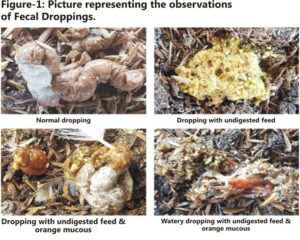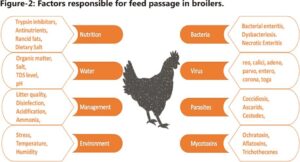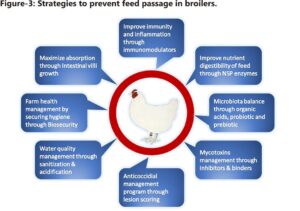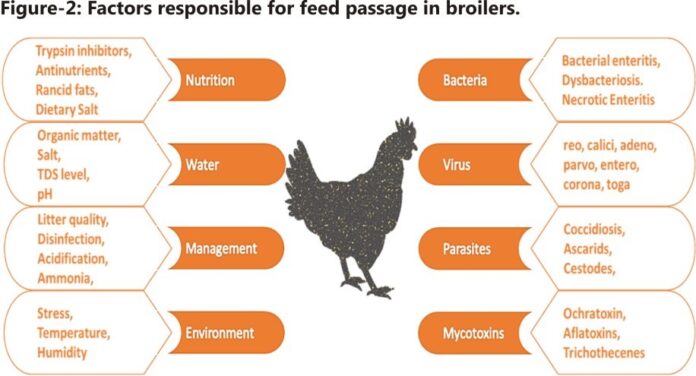Feed Passage Syndrome (FPS) in Broilers : An Integrated Approach to Improve Birds Health
The presence of undigested feed in droppings is commonly known as ‘feed Passage’. This will lead to poor performance of flock involving less weight gain, poor growth; disturb flock uniformity and ultimately the flock production. This condition is more prevalent in young flocks rather than in older ones. If it is untreated it may cause the significant mortality from 2% to 50%.The mortality is not the actual loss in this condition but the flock get disturbed in skeleton development and flushing that leads to less uniform flock and ultimately future peak production and is persistency is at risk. Bird become immune compromised for other diseases.
This condition has not one or two causes but a list that can be the possible factors for this condition. It’s actually the disturbance in normal gut micro flora that leads to high count of clostridium in the gut that are gram-positive, obligate, anaerobic bacteria It is usually isolated on blood agar, incubated anaerobically at 37°C (98.6°F), on which it produces a double zone of hemolysis. There are two primary C perfringens types, A and C, associated with necrotic enteritis in poultry. Toxins produced by the bacteria cause damage to the small intestine, liver lesions, and mortality. This disturbance in the normal gut micro flora can be named as Dysbiosis , Dysbacteriosis , Feed passage syndrome, wet litter syndrome, unspecific enteritis.
Production of broilers with high growth rate and feed efficiency through impressive genetic improvement is often directly linked with digestive problems, such as passage of undigested feed (or) feed passage syndrome with impaired gut health function. The passage of undigested feed inside the poultry house is a sporadic problem in integration or individual farms mainly during rainy season. This may be due to the limited availability of major raw materials in diet and poor management practices. The incidence was close to that observed during 1996 due to poor grain harvesting after consecutive years, but the severity is much lower at present. According to the statistical analysis, the loss of feed at one chicken was around 0.08USDdue to feed passage, apart from the cost of medicine.
Many factors should be considered to influence the rate of feed passage through the digestive tract in birds, e.g. nutrient interaction time with digestive enzymes, absorptive surfaces and microbial populations.

The main observation as shown in Figure-1 is the presence of large corn particles, excess moisture, a characteristic green coloration with orange mucus and poor formation to the feces. Affected broilers had poor pigmentation, deprived feed conversion, lower body weight and variable flock uniformity. The lesions are primarily observed on the proventriculus, gizzard and small intestine.
Major challenges for poultry farmers and veterinarians are the passage of undigested feed or wet droppings which are the typical finding related to a wide scope of potential causes. But many times, broiler farmers tend to point out the quality of feed. However, lack of consistency of the issues in farm indicates that the additional factors can also be addressed. This article mainly deals with the summary of causes and preventive measures that should be considered when passage of undigested feed is noted in broilers.
Factors Responsible For Feed Passage
Normal function of intestinal tract mainly depends on the presence of large bacterial population and any imbalance in this flora is mainly responsible for disease. Utmost important cause after viral or parasitic infection is the necrotic enteritis, which may be due to secondary bacterial infection or dysbacteriosis caused by C. perfringens. Overgrowth of C. perfringens occurs due to coccidiosis, which damages the gut lining and reduces the intestinal passage of ingesta. Younger broilers with clinical and sub-clinical coccidiosis usually associated with the species, E. acervulina and E. maxima can cause passage of undigested nutrients in the feces. Similarly, mild infestation of ascarides and cestodes cause gut irritation and feed passage. Some common factors responsible for feed passage in broilers are detailed in Figure-2.

Poor grain quality with mold growth is a primary contaminant source for mycotoxins, which affect the functioning of digestive system and hinders proper digestion of feed. Common examples are: ochratoxins increase intestinal fragility, aflatoxins decrease bile secretion due to blockage of bile ductsandtrichothecenes causes erosions to oral cavity, proventriculus, gizzard and intestine. Both the quality of feed and drinking water should be prime suspects whenever feed passage becomes prevalent. Poor quality water with high level of total dissolved solids (TDS), minerals and pH causes irritation in the gut and inefficient nutrient absorption leading to rapid feed passage. Anti-nutritional factors like gizzerozine, biogenic amines, tannins, trypsin inhibitors and rancid fat further worsen the process of feed grinding by causing gizzard erosions, sloughing of intestinal epithelia, enteritis, etc. Some authors claimed that trypsin inhibitors present in soybean meal (SBM) was directly linked to feed passage outbreaks. Similarly, feed ingredients like wheat, barley, rye or cassava (tapioca or yucca) often cause excess wet droppings due to high content of soluble non-starch polysaccharides (NSP’s). The digesta produced by high levels of NSP’s makes favorable conditions for potentially harmful bacteria, such as C. perfringens.
Faulty management practices of acidification, disinfection, sanitization, litter, ammonia, etc. can increase intestinal bacteria proliferation and make animals more prone to dysbiosis. Sometimes, the level of excess salt intake can result from mixing errors in the feed by not considering the level in fishmeal and drinking water responsible for voiding excess water through the feces with undigested feed. Litter is the first material that recently placed young chicks may consume, before finding feed and water. Ingestion of contaminated litter can cause irritation of the gut linings of young chick, resulting in poor nutrient absorption. Equally, environmental stress conditions should not be ignored as a potential cause of wet and poorly formed feces. High temperature and humidity in the broiler house will increase water consumption and the moisture content of droppings.
Preventive Measures
As referred earlier, the fundamental circumstances wherein feed passage happens is either when there is disintegration on the tissues of gut that impede its working or when there is intestinal microbiota imbalance. It is therefore critical to recognize the reasons rapidly and to make suitable strides before a substantial issue creates. When remedial measures are set up, birds normally recover equally fast. The regular use of functional additives (organic acids, exogenous enzymes and prebiotics) play a crucial role in keeping up great well-being and decreasing the assimilation of pathogenic microorganisms of the digestive tract of birds. It is well known that protected butyric acid is an excellent growth promoter as it enhances performance, regulates gut health issues caused by bacterial pathogens, promotes the regeneration of necrotic areas and facilitate tissue development and repair. Close monitoring of the effectiveness of anticoccidial management program is another step to consider. In the event that the sub-clinical issue continues at farm level, any current anticoccidial program should be re-evaluated to improve disease management, may be by changing the turn of anticoccidials in feed or implementing appropriate vaccination. Some strategies that need to be followed to prevent feed passage in broilers are shown in Figure-3.

Quality of feed ingredients should be improved by focusing on the consistency of grains, soya and fat quality; addition of enzyme preparations to avoid undigested feed to be the substrate for pathogenic microorganisms. Modification of the diet and addition of exogenous enzymes to wheat, barley, oat or rye-based diets can considerably decrease NSP level and reduce the risk of necrotic enteritis in flocks fed with these cereals. Minimizing the level of fishmeal, wheat, barley or rye in the diet can help prevent this condition. Apart from this, such type of issues can be avoided by desirable feed quality along with everyday cleaning and disinfection of feeding equipments; removal of any caked and moldy residues lodged within the system.
It is essential to avoid development of mold in feed by feeding quality grains and storing the feed under appropriate conditions. Mold inhibitors and binding agents should be included in grains to decrease the negative impacts of mold development and mycotoxins individually. Incurable or diseased birds should be removed promptly, as they can serve as a source of toxicosis or infection due to cannibalism. To govern the problem of drinking water, disinfection or acidification remedy can be validated. Management practices should be streamlined by paying attention on litter quality, farm hygiene, field of feeding, temperature and humidity of the house. It is necessary to make sure that the litter is of top quality, free from foreign materials and fresh.
Clinical Symptoms:
- Undigested feed in droppings
- Diarrhea
- Droppings lose their shape and compactness and watery and without white uric acid white cover.
- Reluctant to move, lethargic and depressed
- Bird Hides under drinkers
- Light weight , keel bone apparent
- Water to feed ratio increases
- Poor pigmentation of legs
- Ruff feathers
- Feed in the crop
- Poor FCR
Possible Causes of the Undigested Feed:
Infectious diseases that affects gut , proventriculus , gizzard and intestinal epithelium includes worms infestation ,coccidiosis and enteritis
Mycotoxicosis Different types of mycotoxins affect the functioning of the digestive system, hindering proper digestion of feed. In fact, some major feed passage outbreaks have been associated to poor grain quality. For example,
Ochratoxins increase intestinal fragility (Albassam et al, 1987)
Aflatoxins decrease bile secretion, impairing feed digestion and absorption. (Newberne et al, 1969)
Trichothecenes cause erosions to proventriculus and gizzard (Hoer at al, 1982).
Lesion in proventriculus affect the secretion of hydrochloric acid and erosions in gizzard worsen the processof feed grinding.
Feed Nutrition Alterations T rypsin inhibitors present in soybean meal have been directly linked to feed passage outbreaks(Ruiz, N 2012). Safe levels < 3 mg/g.
Antinutritional factors (gizzerozine, biogenic amines) and some vitamin deficiencies cause gizzard erosions, worsening the process of feed grinding.
Rancid fats are claimed by some authors as a common cause of feed passage, but many otherresearchers state that feeding broilers with of high peroxide value fats does not produce significant
lesions in the digestive system (Choque et al, 2007; Baucells et al, 2008; McGill et al, 2011)
Intestinal changes in intestinal motility, modified cations of gastric acidit reduction in the production of bacteriostatic peptides in the pancreas alterations in the amounts of mucus produced or in its composition.
Stress any perturbation in gastroenteric physiology or immunity of the bird caused by temperature stress (heat or cold) or other environmental discomfort can cause dysbiosis and/or enteritis associated with lower absorption of nutrients by the host. Exposure to the stress hormones norepinephrine and epinephrine, signif cantly increases the proliferation of several enteropathogenic bacteria, such as Escherichia coli, Yersinia enterocloitica, Pseudomonas aeurinosa, Salmonella enteritidis, Salmonella cholerasuis, and Salmonella typhimurium. Even under the best nutritional conditions, environmental stresses in commercial production conditions can increase intestinal bacteria proliferation and make animals more prone to dysbiosis. This situation is more frequent in young animals with unstable and immature microflora or immunosuppressed animals
Post Mortem Findings:
- Emaciated and dehydrated bird that is due to enteritis and diarrhea
- Cholangiohepatitis (CAH)in chickens is characterized by inflammatory proliferative and dystrophic necrobiotic alterations in bile ducts and the liver parenchyma. Usually, no clinical signs are observed. The increased daily mortality is insignificant, although in some chickens, a retarded growth and dehydration could be present.
- Undigested feed in the intestine
- increased water/feed ratio.
- Inflammation and congestion of intestines.
- Thin, transparent, fragile intestinal wall
- Intestinal wall loose its thickness
- Intestinal villi and mucosa slaughed off
- Presence of worms i.e ascardia
- Greenish or yellowish material inside the intestine
- Kidneys may be sawollened and urates deposit there
- Gas formation in intestine
- Severe enteritis including hemorrhages
- In many occasions dysbacteriosis is accompanied by lesions in gizzard. The reason for this phenomenon is not known exactly, but could be explained by the investigations of some researchers that link increased occurrenceof gizzard erosions to flora imbalance, specially to higher Clostridium counts, in some parts of digestive tract (Novoa-garrido et al, 2007).
Prevention and Treatment:
As mentioned above, the main situations in which feed passage occurs is either when there are erosions on thetissues of gut that impair its functioning or when there is intestinal flora imbalance. Plant extracts can be used to
- Restore or maintain the integrity of digestive tissues
Immunity: some phytochemicals, such as some compounds contained in garlic extract, are able tostimulate local gut immunity (Ota et al, 2012).
Antioxidant compounds, such as those contained in marjoram or cinnamon, are beneficial againstintestinal inflammation.
Improve feed digestibility: Sweet bay induces a higher secretion of bile acids; cinnamon stimulatesthe secretion of digestive enzymes. Improved digestion means that there are less substrates forpathogenic microorganisms to grow.
Direct action on tissues: Chicory is able to modify the morphology of the intestinal epithelium, by increasing the villus length and crypt depth, and thus amplifying the absorptive surface and and maintaining a healthy intestine.
- Restore or maintain balance of intestinal microbiota
Microbiocide: cinnamon, marjoram or garlic have proven to be natural bactericides are able to reduce the load of pathogenic microorganisms in case of imbalance. Unlike antibiotics, they do not exert a germicidal action which can reduce the numbers of useful microbes.
Prebiotics: chicory feeds beneficial lactic acid bacteria and promotes their growth exponentially.
Antibiotics:
Addition of antibiotics in the feed such
- virginiamycin 20 -40 g/ton feed
- Bacitracin 50 g/ton feed
- lincomycin 20 g/ton feed
- Neomycin 70-140 g /ton feed
- Oxytetracycline 400-600 g ton feed
- The minimizing the level of fishmeal, wheat, barley, or rye in the diet can also help prevent this condition. When higher amounts of wheat, barley, or rye are necessary, use of enzymes for non-starch polysaccharides in the feed has reduced the level of necrotic enteritis in flocks fed these cereals.
Treatment for necrotic enteritis is most commonly administered in the drinking water, with bacitracin (200–400 mg/gal. for5–7 days), penicillin (1,500,000 u/gal. for 5 days), and lincomycin (64 mg/gal. for 7 days) most often used. In each case, the medicated drinking water should be the sole source of water. Moribund birds should be removed promptly, because they can serve as a source of toxicosis or infection due to cannibalism.
Conclusion
Factors associated with feed passage in broilers can negatively affect the gut health status and production performance of birds. The most efficient manner to resolve the problem is to evaluate the basic management practices that play a vital role in preventing this problem. Feed passage directly affects the broiler economic performances like feed conversion and body weight. Therefore, a standardized scoring technique can be used to evaluate the sub-clinical issues related to intestinal health in general to make the modification of strategies accordingly. Feed passage in poultry will keep on being an infrequent issue in poultry integrations. It is essential to keep a receptive outlook, as there could be several causes and a little deductive reasoning may be needed to arrive at a diagnosis.
Feed Passage Syndrome

Compiled & Shared by- Team, LITD (Livestock Institute of Training & Development)
Image-Courtesy-Google
Reference-On Request.


